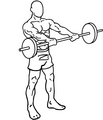Front raise
The front raise is a weight training exercise. This exercise is an isolation exercise which isolates shoulder flexion. It primarily works the anterior deltoid, with assistance from the serratus anterior, biceps brachii and clavicular portions of the pectoralis major. The front raise is normally carried out in three to five sets during a shoulder workout. Repetitions depend on the a lifter's training program and goals.
Form
To execute the exercise, the lifter stands with their feet shoulder width apart and weights or resistance handles held by their side with a pronated (overhand) grip.
The movement is to bring the arms up in front of the body to eye level and with only a slight bend in the elbow. This isolates the anterior deltoid muscle (front of the shoulder) and uses the anterior deltoid to lift the weight.
When lifting it is important to keep the body still so the anterior deltoid is fully utilised; if the weight cannot be lifted by standing still then it is too heavy and a lower weight is needed. It is important to keep a slight bend in the elbow when lifting as keeping the elbow locked will add stress to the elbow joint and could cause injury.
A neutral grip, similar to that used in the hammer curl, can also be used. With this variation the weight is again raised to eye level, but out to a 45 degree angle from the front of the body. This may be beneficial for those with shoulder injuries, particularly those related to the rotator cuff.
Gallery
-
Barbell raise start
-
Barbell raise end
-
Dumbbell raise start
-
Dumbbell raise end
-
Can be done while holding 2 at once, alternating or together


